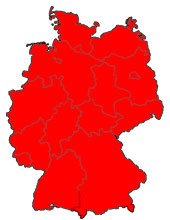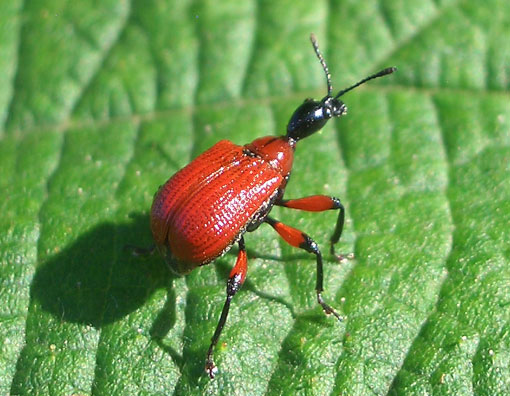Subspecies
No information has been entered yet.
Synonyms
Apoderus coryli (Linnaeus, 1758)
Additional German name: Haselnuss-Dickkopfroller
Identification
Medium sized beetle, body length between 6 and 8 mm. Mainly red or
orange-red, but with black head, antennae and distal ends of the legs.
Very characteristic elongated head and narrow prothoracic shield, which
gives the animal a "long-necked" appearance. There are very rare variants
with a different colour pattern, e.g. the head may be partially red, and the extent of the red base of the legs may vary.
The eggs are smooth, shiny and yellow. The larvae are about 1 cm long and greenish-yellow to orange
with a chestnut-brown head. The pupa has the same size as the imago and is deep orange with relatively
long wing pouches.
Distribution
Widely distributed in Europe (except the north) and throughout Asia to
Japan. In Germany the species is quite common and currently not
threatened.

Fig. 1: Distribution of Apoderus coryli in Germany.
Biology
Overwintering imagines appear in spring and mate in May to June. The
females cut and roll hazel leaves (sometimes also leaves of other trees
like alder (Alnus) or birch (Betula)) to form a cigar-shaped hiding
place ("cradle") for the larvae. They usually also damage the median
leaf vein,
i.e. the leaves later wilt in order to be more easily digested by the
larvae, but they do not disrupt the leaf veins completely to prevent the
leaf from becoming dry and hard or falling off. The female bites a hole
into the rolled leaf and deposits up to 6 eggs (but usually only 1 per
leaf) into the roll. It may take several weeks until the females have
deposited all their eggs in a high number of rolled leaves. The
larvae hatching from these eggs remain in the rolled leave, feed from
the leaf tissue and
finally pupate still within the leaf roll. The next generation of
imagines hatch starting from June. They remain on the host plant until
autumn and then overwinter dug in the soil. A partial second generation
may be produced by these imagines in the summer; these larvae do not
complete metamorphosis in the same year, but overwinter in the
fallen-off rolled leaves and then pupate in spring. The habitat of this
species is hedges and deciduous forests, wherever the food plants occur (also parks and gardens).
The present species is attacked by a number of hymenopteran parasites.
So far recorded are: Ichneumonidae: Gelis acarorum, Gregopimpla
flavipes, Gregopimpla inquisitor, Scambus calobatus, Scambus
longiventris, Scambus planatus. Braconidae: Blacus maculipes.
Encyrtidae: Copidosoma flavomaculatum. Eulophidae: Achrysocharoides
cilla. Trichogrammatidae: Poropoea stollwerckii (
Rheinheimer and Hassler 2010).

